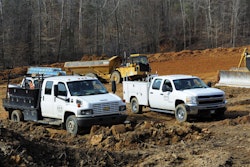Extended Oil Drain Intervals
 It pays fleets to analyze both lube cycles and the lubricants
It pays fleets to analyze both lube cycles and the lubricants
By Robin Walton, CPA
Invoices for oil changes have been coming across my desk for as long as I can remember. Money spent on oil changes now can mean avoiding much larger repair costs in the future. However, we’ve seen significant savings as oil change intervals have increased on our newest pickups.
This doesn’t mean we are gambling with engine repair costs. Advances in engines, oil, filters, fuel and emission controls have all contributed to keeping oil effective for more miles. The old school “3,000 miles or three months” is a faint echo of years gone by.
In many cases, mileage is not the best indicator of when to renew the lubrication in vehicles. There are other options to help you decide when it is cost effective to change the oil. Some approaches can actually extend the useable life of the oil itself.
TAKE IT FROM THE TOP
The big three pickup manufacturers now employ proven systems which use complex algorithms (effected by vehicle use) to determine when a vehicle needs an oil change. Such systems do not directly monitor the oil via sensors. Here’s how they work:
The GM Oil Life System (GMOLS) was engineered to take in account four different oil characteristics – oxidation stability, acidity, alkalinity and viscosity change. The system optimizes oil change intervals based on vehicle and environmental operating conditions. GMOLS comes standard on 97 percent of GM vehicles sold in the United States.
Ford’s Intelligent Oil-Life Monitor is designed to “simplify decision about oil change intervals, make it easier for customers to bundle multiple maintenance tasks during service visits and provide reassurance that long-term reliability of the vehicle is maintained with engine oil in good condition.”
Ram recommends that you heed the “Oil Change Required” display on the Electronic Vehicle Information Center (EVIC). In addition they recommend changing the oil if it has been six months since last oil change, you drive your vehicle off-road for extended periods of time, or oil change intervals exceed 8,000 miles.
These systems represent years of proven testing by the best engineers in the industry who have concluded that oil change intervals should be determined by vehicle use as monitored by the truck’s computers. If your fleet includes newer vehicles with oil monitoring systems, take advantage of the extended intervals to save fleet maintenance costs.
OIL ANALYSIS
You can determine the condition of the oil by sending samples to a laboratory. Testing can gauge the health of the engine, determine if the oil is working well with the specific engine, and facilitate decisions about extending the oil drain intervals of the pickups in your fleet.
Total Base Number (TBN) is an important term in oil analysis. It’s a measurement of the amount of active additive left in a sample of oil. Comparing the TBN of used oil to the same oil in its new condition determines how much additive is left in the oil to neutralize viscosity-killing acids accumulating from combustion and other sources.
Out-of-warranty vehicles in your fleet can benefit from extended intervals when oil tests indicate sufficient lubrication.
Oil analysis can also alert your mechanics to engine problems. For example, coolant system failures can contaminate the oil supply for the engine, rapidly degrading the oil – oil analysis can catch such a problem before you would ever see discolored oil.
When you’re considering increasing the intervals of oil changes for vehicles without monitoring systems, you need to take into account if the use of the vehicle. “Severe duty” means shorter intervals.
Severe duty includes:
• Operating in sustained temperatures less than 10°F or over 100°F
• Use of biodiesel up to B20
• Use of E85 fuel more than 50% of the time
• Driving off-road frequently
• Driving in dusty areas
• Towing a trailer or hauling a heavy load
• Idling or extended low-speed operation
• Consistent heavy or rush-hour traffic (low average speed)
Synthetic or Conventional Oil?
The use of synthetic lubricants can be worthwhile in cold climates for improved cold start lubrication. Generally, synthetic oils have higher initial TBNs, and contain less multi-weight viscosity improvers, which break down over time. Watch for filters specifically designed for use with synthetic oils.
BENEFITS OF EXTENDED OIL CHANGE INTERVALS
Benefits of longer oil drain intervals can include:
• Lower operating cost
• Purchase less filters
• Purchase less oil
• Can help align routine maintenance to be performed at the same time
• Keep vehicles on the road longer minimizing service time
• Environmental benefits
• Use less of a finite natural commodity
• Reduce used waste oil
• High efficiency filters and oil analysis can help to reduce engine wear
• Reducing maintenance
• Extend time between engine overhauls
Initial testing equipment costs, oil analysis fees and the length of time to see ROI may discourage some fleet owners, but there is potential to save money around oil change intervals.
Ensure that your technicians are educated on the newer recommendations and procedures associated with oil change intervals. If they are not already following manufacturer recommendations or following the oil life monitor equipped in your vehicles, you’re literally pouring money down the (oil) drain.
OIL SPOILERS
Having a properly sealed air filter is important for oil life. A fuel system that is working properly, including sensors and the like, to ensure the combustion is burning at the correct air fuel ratio ensures there is less opportunity for fuel contamination to the oil. A proper functioning cooling system ensures that the engine reaches and maintains proper operating temperature – extreme temperatures can cause premature oil deterioration.
 About the author: Robin Walton has been a licensed contractor for more than 20 years and has 16 years of financial accounting and systems experience. With a degree in accounting/economics and hands-on construction experience, she understands the day-to-day business of contractors and landscapers.
About the author: Robin Walton has been a licensed contractor for more than 20 years and has 16 years of financial accounting and systems experience. With a degree in accounting/economics and hands-on construction experience, she understands the day-to-day business of contractors and landscapers.








